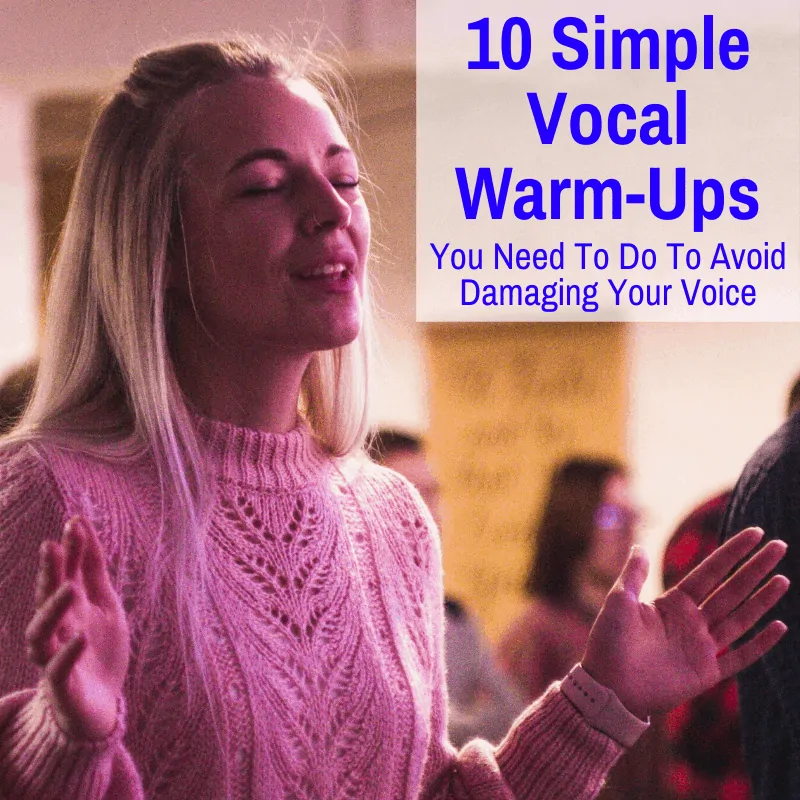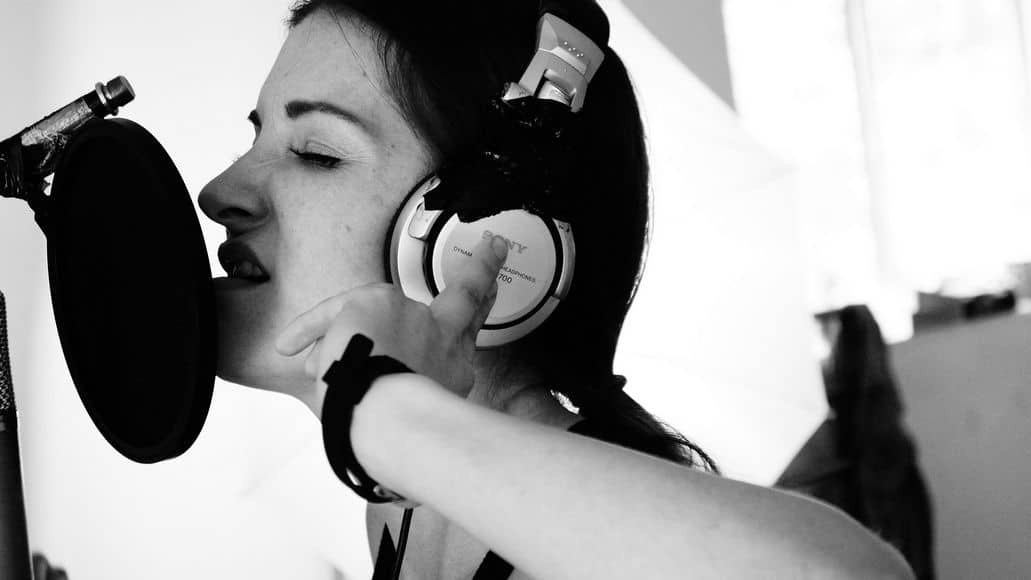 We all know you need to warm up before playing a sport.
We all know you need to warm up before playing a sport.
You can feel it.
If you don’t warm up first, your muscles feel tight. Only after warming up do you feel loose and ready to hit the gym, court, field, etc.
Things aren’t quite so obvious when it comes to singing.
We can’t see the muscles involved and they don’t feel noticeable tight either.
But warming up before singing is every bit as important as warming up before exercising.
Singing also uses muscles, and not properly warming those muscles up can lead to serious injury.
And just like warm-ups in the gym, there are good warm up routines and bad ones.
The good ones ease your muscles into action and ready every muscle that needs to be ready.
A good singing warm-up starts you out slow and finishes with every singing muscle warmed up properly and ready for that practice session or performance.
But with so many bizarre and often useless warm-up routines out there, it’s hard to know which exercises you should be doing.
That’s why we’ve gathered the ten featured here. We want you to be sure you are warming up your vocal muscles properly before using them.
Table of Contents
- 1 Why Vocal Warm-Ups Are Important
- 2 Easy Vocal Warm-Ups
- 2.1 How To Do Vocal Warm-Ups Correctly
- 2.2 Exercise 1: The Humming Technique
- 2.3 Exercise 2: The Arpeggio Warm-Up
- 2.4 Exercise 3: Yawn-Sigh Exercise
- 2.5 Exercise 4: Lip Buzzing Warm-up
- 2.6 Exercise 5: Tongue Trill Technique
- 2.7 Exercise 6: Vocal Siren Warm-ups
- 2.8 Exercise 7: The Vowels Exercise
- 2.9 Exercise 8: Vocal Straw Phonation Technique
- 2.10 Exercise 9: Vocal Slides Warm-Up
- 2.11 Exercise 10: The Mum Exercise
- 3 Simple Vocal Warm-Up Exercises: Pace Yourself
Why Vocal Warm-Ups Are Important
When you sing, you use one of the fundamental aspects of sound: vibration. Vibration moves through all of your body parts, including your bones, muscles, ligaments, etc. in order to allow your vocal cords to produce a sound.
Singing causes intense vibrations and vocal warm-up exercises prepare you for this.
Controlled and adequately warmed up muscles surrounding your vocal folds will help you sing well, because those muscles will perform more effectively.
How?
It will strengthen your vocal folds as they open and close when you sing.
For instance, if you want to belt out a song with an A4 note like “Thinking Out Loud” by Ed Sheeran or “Stay With Me” by Sam Smith, your vocal cords need to open and close 440 times each second.
That means that for anyone to hit an A4 note as demonstrated in the video below, your vocal folds need to be strong enough to open and close 440 times per second!
And that’s just for the A4 note!
Sopranos with a higher voice range often need to hit notes that require more than 1000 vibrations per second. Vocal exercises are the key to preparing your voice to keep up with this level of singing.
Primary Benefits Of Vocal Warm-Ups
Just like stretching has many benefits for athletes or gym-goers, so does warming up your voice to a singer. Here are some of the reason why you should take the time to warm up and condition your voice regularly.
- It will increase the blood flow to your vocal folds and muscles that control your voice and produce sound.
- Vocal warm-ups can also aid in thinning out or facilitating the removal of excess mucus secretions that you may have on your larynx or vocal folds (this is especially important when you need to sing with a cold).
- It will help you increase your range and tone.
- Injuries to your vocal apparatus are less likely if you warm up before singing.
- It will help enhance your voice, including the development of your vocal range, breath control, agility, vibrato, diction, tonal contrast, and consistency.
Easy Vocal Warm-Ups
There are many different exercises you can use to warm up your voice before singing, so you have a lot of options. And although we may have varying vocal ranges and singing styles, there are general guidelines that work for everyone.
In this article, we have compiled the most popular and effective vocal exercises to help you sing better and avoid injury. As with any training or warm-ups, there is a right way and wrong way to do them. So remember these three tips before you do any vocal warm-ups.
How To Do Vocal Warm-Ups Correctly
- Warm up for 30 minutes a day
- Focus on the exercises.
- Have water handy
Now let’s get to the actual warm-up exercises every singer should be doing before every practice session or performance.
Exercise 1: The Humming Technique
The humming technique is probably one of the gentlest ways to warm your voice up because it does not put a lot of strain on the vocal cords. It is a simple exercise that we can all do, anytime, anywhere.
Here’s a clip of Cari Cole, a celebrity vocal coach and artist development expert, talking about how to warm up with humming.
In summary, here’s how to do a humming exercise.
While keeping your mouth closed, keep your tongue in a relaxed position. Then, start to hum (produce a sound as if you are saying “hmmm” with your mouth closed). Do this up and down a major scale.
Exercise 2: The Arpeggio Warm-Up
If you have a bit of history in studying music or have been doing it for a while, you have heard the term ‘arpeggio.’ If not, do not be intimidated by it. An arpeggio is a broken chord (a one, three, five, eight of the chord).
They are not only useful as a vocal warm-up exercise, but also as a training exercise! You can practice arpeggios using vowel sounds such as “ah” or “oh” or “ee” or even use a phrase.
Here’s a video for you to follow and do arpeggios.
Exercise 3: Yawn-Sigh Exercise
The yawn-sigh exercise is not just for singing. It is also used as a speech therapy technique. In fact, the yawn-sigh exercise is one of the most effective therapy techniques to minimize tension in the vocal cords.
For this easy vocal exercise, simply yawn (like you do when you are sleepy). Then, breathe out through your nose as if you are sighing. Watch the video below:
How is this useful? It lowers your larynx and widens the pharynx, which prepares your vocal tract for effortless voice production and enhanced resonance. This warm-up will help you relax your voice and improve its range.
Exercise 4: Lip Buzzing Warm-up
Here’s another simple technique, as far as vocal warm-ups go: the lip buzz warm-up, also know as the lip trill.
Just try to follow the instructions in the video above. And remember that the goal for lip trill is to make a sound that makes your lips vibrate as you blow air,both through your mouth and nose. You can do this with or without pitch slides.
Exercise 5: Tongue Trill Technique
Have you ever heard a cat’s purr? If yes, it’s the kind of sound a tongue trill produces, except you roll your ‘R’ more. It may be challenging to do at first, but here is an explanation on how to warm up with it.
Keep in mind that a tongue trill involves curling the tongue and producing an R sound as you go through your personal range from low to high.
Exercise 6: Vocal Siren Warm-ups
Much like the pitch glide, this exercise makes a siren-like sound similar to what you hear from ambulances or police cars. You want to produce an “oooo” sound that starts from the lowest note of your range and climbs to the highest. The sound it makes is continuous and should cover all the tones between the notes.
Check out the video below about the vocal siren:
Just like it was explained in the video, try to glide up the notes and then back down. It will help you connect with your breath energy.
Exercise 7: The Vowels Exercise
As singers, you want to make your vowels and your diction nice and clear. Here’s a clip focusing on vowel singing.
This is the best exercise to achieve a clear and perfect diction. You can start by singing through the vowels “ae-ee-ah-oh-oo” on any note and go up or down your range.
Exercise 8: Vocal Straw Phonation Technique
Also known as straw phonation, the vocal straw exercise is a simple vocal technique using a mouth that is partially closed. Check out Valerie White Williams in the video below as she demonstrates how to do the straw phonation technique.
To perform this exercise, get a straw and begin by performing the humming exercise. Hum from your lower range and slide up to your highest range slowly and evenly. You can hum with your favorite song if you like. For variety, you can also blow controlled bubbles through a straw in a partially full glass of water.
Exercise 9: Vocal Slides Warm-Up
The vocal slides warm-up is a technique that is also known as “portamento”, an Italian word that means “the act of carrying.”
Much like the vocal siren technique, you do this by sliding from one note to the next in your vocal range, except that you do not sing the in-between notes.
Exercise 10: The Mum Exercise
The mum exercise is a lot of fun! It is designed to help you control your transitions between chest and head voice. To do it, just sing “Mum, mum, mum mum mum.” It will also help bring resonance out of your throat properly.
Check out the clip below on how to warm up with the mum technique.
Simple Vocal Warm-Up Exercises: Pace Yourself
We all know that singing can be physically demanding. It takes a lot of practice, patience, energy, and stamina to learn to sing beautifully. And for this reason, singing should involve warm-ups, just like any other physical activity.
And if you are having a hard time accomplishing all the vocal exercises listed above, don’t worry.
These exercises should be challenging, just like a warm up in the gym should be challenging. If you keep doing it, it becomes easier and easier.
One critical difference, though, is that you should not feel sore from these warm-ups, like you do after a gym warm-up.
Vocal exercises, when properly executed, should reinforce good habits and not strain your muscles. Your throat should not hurt from singing.
Don’t rush. Pace yourself and in no time, you’ll be amazed at how much better you can sing.

Leave a Reply